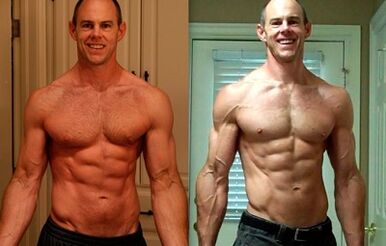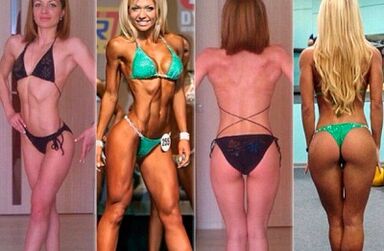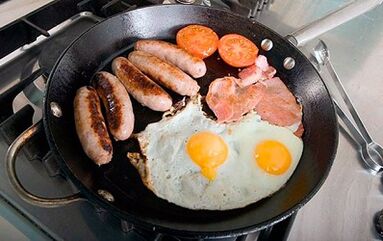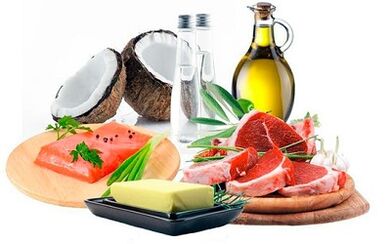
Many people who control their weight have noticed more than once that, having briefly abandoned flour, sweets, potatoes and cereals, their weight quickly drops by a few kilograms.This is due to rapid carbohydrate restriction.Without receiving the usual daily dose of glucose, the body begins to look for other sources of energy and switches to fats and proteins.
Limiting carbohydrate foods is the basic principle of the famous low-carb diet.But, in addition to the sensational Kremlin diet and the Atkins diet, there is another more strict, but at the same time more effective system of nutrition - the keto diet.
Keto diet, what is it?
The keto diet is a protein and fat diet with an almost complete absence of carbohydrates.This is one of the few diets known in our time that allows you to eliminate subcutaneous fat and at the same time maintain muscle mass.The main goal of the keto diet is to force the body to quickly switch from glycolysis to lipolysis.Glycolysis is the process of breaking down carbohydrates and lipolysis is the process of breaking down fats.The latter is only triggered when glycogen stores in the liver and muscle tissue are completely depleted, usually within a few days.During lipolysis, fats are broken down into free fatty acids and glycerol, which are subsequently transformed into ketone bodies.The process of forming ketone bodies is called ketosis, hence the name of the diet itself.
Body adaptation to ketosis and diet duration
Unlike a regular low-carb diet, the keto diet is longer and more systematic.During the first week, the body adapts to the changes by eating reserves, and only closer to the second week does the burning of subcutaneous fat begin.
The body's preparation for ketosis occurs in 4 steps:

- Total glucose consumption.During the first 12 hours after the last meal, the body uses glucose obtained from carbohydrates;
- Complete glycogen consumption.Within 12 hours, the body is able to process all the glucose and begins to remove glycogen reserves from the liver and muscles.This phase lasts approximately 1-2 days;
- Fat and protein consumption.This is the most difficult period, because having exhausted all carbohydrate reserves, the body begins to process not only fatty acids, but also tries to produce the required amount of glucose from proteins.At this stage, the body tries to use proteins, including muscle proteins, as the main source of energy;
- Ketosis, fat consumption.This stage occurs approximately on the 7th day of the diet.The body adapts to the lack of carbohydrates and begins ketosis.The breakdown of your own protein and dietary protein slows down and fat eventually becomes the main source of energy.
The keto diet can last 2 to 3 weeks depending on your goals.In the first week the body processes reserves and adjusts to a new diet, and only from the second week does ketosis begin, so if you plan to cut back a little and spend just a few days doing this, the keto diet is not for you.In this case, it is better to consider a simpler and more common low-carb diet.It is very important to exit the keto diet correctly and gradually return to your normal diet, adding a maximum of 30 grams of carbohydrates per day.
Who is the ketogenic diet recommended and contraindicated for?
To function properly, the human body needs three main nutrients: proteins, fats and carbohydrates.
They are found in normal food and each performs its own function:
- Fats are a kind of rigid barrier of internal organs, which also accumulates fats under force majeure circumstances;
- Proteins are the main building material for muscles, joints and the entire body.Without it, you will never be able to develop muscles and build a beautiful, sculpted body.These organic substances are vital for professional athletes and all people who lead an active lifestyle;
- Carbohydrates are the main source of energy.They are what give us vigor and vitality.
Entering the body in moderate and proportional quantities, proteins, fats and carbohydrates are equally useful and necessary.That is why people who actively play sports and control their diet never have problems with being overweight.But if a person leads a sedentary lifestyle, regularly overeats or eats chaotically, often indulges in fast food, confectionery and other sweets, this causes an excess of fats and carbohydrates in the body, which gradually turn into subcutaneous fat.The keto diet will help you lose excess weight and “flush” excess fat from your body.It will appeal to people who have difficulty limiting themselves in food and counting calories.It is also essential for athletes during the drying period.Before starting this diet, it is important to consult a nutritionist and have a complete body examination.The keto diet can give tangible positive results, but only if the person is healthy.
The keto diet is strictly prohibited for diabetics, pregnant women, people with thyroid gland diseases, as well as those who have problems with the kidneys, liver and gastrointestinal tract.
Advantages and disadvantages of the keto diet

The benefits of the keto diet include fast and effective weight loss.The number on the scale decreases not due to fluid or muscle, but due to the breakdown of fat.During the keto diet, you don't need to fast or constantly count calories.Of course, it is necessary to regulate the amount of food consumed, but the keto diet is not based on cutting calories, but on minimizing carbohydrate foods as much as possible.As a result of the keto diet, you can get rid of fat while maintaining muscle.
The main disadvantage of the keto diet is its imbalance.Eliminating carbohydrates means reducing vitamins, beneficial microelements and also fiber - an essential component for cleansing the body and the proper functioning of the stomach.The lack of vitamins can be compensated by taking a vitamin complex at the end of the diet, but with fiber the situation is more complicated.Its deficiency can cause intestinal and kidney disorders, which is why during the diet it is recommended to consume fruits, vegetables and bran in small quantities to minimize the risk of developing serious illnesses.The main thing is not to overdo it and ensure that the amount of carbohydrates consumed per day does not exceed 50 g.
Limiting carbohydrates has a negative effect on mental and physical abilities, reducing activity and concentration.This is especially serious for people involved in creative or mental activities.This period is often accompanied by increased fatigue, drowsiness and mild apathy.
What can and cannot be consumed during the keto diet?
The majority of your diet while on the keto diet should consist of protein foods:
- Meat (beef, veal, rabbit, poultry and even pork);
- Fish (especially herring, salmon, salmon, tuna);
- Seafood (mussels, shrimps, crabs, squid, etc.);
- Eggs (chicken and quail);
- Nuts (hazelnuts, almonds, pistachios);
- Skimmed milk 0.5 -1.5% fat;
- Low-fat fermented dairy products (cottage cheese, yogurt, kefir) without dyes, flavors, fruit additives and sugar;
- A limited amount of low-starch vegetables, lettuce and unsweetened fruits (sour apples, oranges, grapefruits).
To create the correct keto diet menu, it is important to know not only the permitted foods, but also those that are strictly prohibited:

- Bread;
- Potato;
- Cereals;
- Banana;
- Grape;
- Sugar;
- Chocolate;
- Confectionery (pastry, cakes);
- Any homemade baked goods or baked goods.
Based on these two lists and checking the table of energy values of the products, you can easily create a menu for a week, two weeks or more and stick to it.This data from the energy table will be necessary to control carbohydrates.When writing the menu, you need to make sure that the quantity does not exceed the 50g mark.per day.
Example menu
Breakfast.Two-egg omelet with spinach, half a grapefruit, unsweetened tea.
To have lunch.A light version of homemade Caesar salad.It should consist of green lettuce leaves and boiled chicken breast.You can season the salad with olive oil or lemon juice.You cannot add the usual croutons or sauces that are in the recipe.
To have lunch.Trout steak baked in aluminum foil.
Few people decide to try the keto diet, mainly because it breaks established stereotypes.Many people use the word “diet” to mean strict calorie counting, restrictions on fatty foods, meat, and the transition to so-called “pasture.”While on the keto diet everything is exactly the opposite.Most fruits, vegetables and cereals are excluded from the diet, and eggs, seafood, fish and meat, including fatty varieties, are introduced.






























